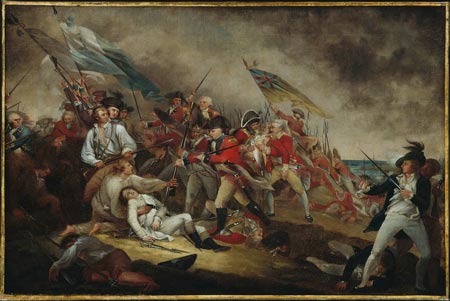Authors:
Historic Era:
Historic Theme:
Subject:
May/June 2000 | Volume 51, Issue 3


Authors:
Historic Era:
Historic Theme:
Subject:
May/June 2000 | Volume 51, Issue 3
Early on the morning of June 17, Gen. Thomas Gage, governor of Massachusetts and commander in chief of British forces in North America, awoke in his Boston home to learn of a serious new threat. On the Charlestown peninsula, which was connected to the mainland by a narrow neck of land, rebel soldiers were building military fortifications on a rise known today as Breed’s Hill. If left alone, they would surely fortify neighboring Bunker Hill as well. Gage conferred with his officers and decided on an immediate attack.

The Death of General Warren at the Battle of Bunker Hill by John Trumbull
Although the Revolutionary War had begun two months earlier with clashes at Lexington and Concord, Bunker Hill was its first full-scale battle. It was also, according to the historian Mark Boatner, “one of the few in the American Revolution that is of real military interest”; most of the conflict was characterized by skirmishes, raids, surprise attacks, and strategic retreats. Indeed, the peninsula’s wide variety of terrain and installations—hills, roads, rail fence, stone wall, breastwork, and the town of Charlestown—all neatly contained in a compact area surrounded by water, can give Bunker Hill more of the flavor of a board game than of an actual battle. This has made it irresistible to armchair generals ever since.
Numerous commentators have criticized Gen. William Howe, the British field commander, for making an assault on Breed’s Hill instead of just occupying the neck of the peninsula and waiting for the Americans to surrender. Boatner contests this assessment. The tides did not favor a landing at the neck, he says, and time was of the essence. If Howe had delayed any longer, the Americans would have finished reinforcing Bunker Hill, adjacent to the neck, and been in a much better position to resist.
Covered by several warships, Howe’s men landed on the beach below Breed’s Hill around 1:00 P.M. While they ate lunch, Howe sized up the American position and summoned reinforcements. Beginning at three o’clock, the redcoats made two unsuccessful charges against the redoubt atop Breed’s Hill and a line of militia sheltering behind a rail fence to its east. Each time they were repulsed with large numbers of casualties, and each time they regrouped to charge again, over the bodies of their dead comrades.
On the third try, reinforced with four hundred fresh troops (and having finally shed their cumbersome backpacks, which weighed more than a hundred pounds), the redcoats withstood yet another withering musket volley. Then the Americans, most of them out of powder and lacking bayonets, finally abandoned their redoubt. Those at the fence followed. A small group of Americans made a stand on Bunker Hill to cover the retreat, and the weary, sweltering, and dazed redcoats chose not to pursue the